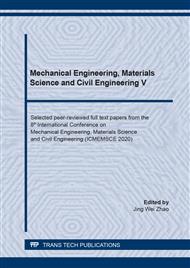p.131
p.136
p.143
p.151
p.156
p.163
p.172
p.178
p.183
Study on the Crack Resistance Properties of Manufactured Sand Concrete
Abstract:
In order to solve the problem of workability and durability of concrete caused by poor particle shape and morphology of manufactured sand and high content of stone powder, which leads to crack problems of concrete, the tensile strength, elastic modulus, shrinkage performance and adiabatic temperature rise performance of manufactured sand concrete were studied in this paper. And the cracking risk factor (the reciprocal of the anti cracking safety factor) of the concrete with the special admixtures and the crack resistant functional materials was calculated by according to GB 50496-2018. The experimental results show that the elastic modulus and tensile strength at the age of 28 d of the test concrete are increased from 31.0 GPa to 34.6 GPA and 2.91 MPa to 4.23 MPa, respectively. The shrinkage performance and adiabatic temperature rise of the concrete are reduced from 98 με to 65 με and 38.9°C to 38.4°C, respectively. The risk factors of surface and center crack resistance of mass concrete floor are 0.52 and 0.75, so the concrete under inspection will not crack.
Info:
Periodical:
Pages:
178-182
Citation:
Online since:
June 2021
Authors:
Price:
Сopyright:
© 2021 Trans Tech Publications Ltd. All Rights Reserved
Share:
Citation:


